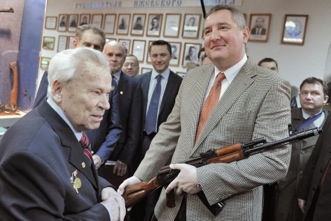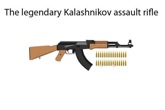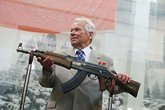Mikhail Kalashnikov, inventor of the legendary AK-47 assault rifle, dies

AK-47 inventor Mikhail Kalashnikov dies at age 94. Source: Reuters
On the evening of December 23, sad news came from the capital of the Russian arms industry, the city of Izhevsk. After being ill for a long time Mikhail Kalashnikov passed away. He was best known for being the brains behind an assault rifle that experts call the best in the history of small arms.
Since November 17, Kalashnikov had been in intensive care in the clinical diagnostic centre of Izhevsk, where he was hospitalized due to gastric bleeding. Over the past 5 weeks, word from Izhevsk was that he was feeling better, but recently alarming news started pouring in. On December 23, the heart of the legend of the Soviet era stopped beating.
Humble origins
Kalashnikov came from a peasant family and as a child was very interested in technical subjects. At the age of 18, he was drafted into the Red Army, where he, to the surprise of many, displayed wit and ingenuity, suggesting ways to improve the engineering designs of tank guns.
In August 1941, Kalashnikov went to the front. Two months later he sustained a serious injury and was taken to the hospital, where he spent most of his free time working on plans and sketches for the future AK-47, which would eventually immortalize the name Kalashnikov.
The engineering ideas proposed by Kalashnikov did not go unnoticed by the largest gunsmiths of that time and he was assigned to the Main Artillery Directorate of the Red Army, where he later headed the design bureau.
Kalashnikov constructed his famous assault rifle in 1947. Since then, the world has bought over 70 million units of all modifications of the rifle. Today, the AK is used by security agencies in over 100 countries and is included in the list of outstanding inventions of the 20th century.
During his life, Kalashnikov won dozens of government awards and became a true legend not only on a national but also on a global scale.
“Kalashnikov was our national treasure, a man who is born once in a thousand years, by his engineering genius he surpassed a constellation of outstanding gunsmiths,” says Igor Korotchenko, chief editor of National Defence magazine.
Korotchenko met Kalashnikov many times and has the fondest memories of him. “Mikhail Kalashnikov, despite his age, remained serene. Although, the years certainly affected his physical condition, he lived for the interests of the plant and thought globally.”
According to Korotchenko, Kalashnikov actively campaigned for a ban on the uncontrolled proliferation of small arms and for the implementation of supply exclusively through government agencies. “He always said that rifles do not kill, people kill.
Defence analyst Dmitry Litovkin says that Kalashnikov was a living legend and a symbol of the fact that Russia is able to produce the best weapons in the world. Litovkin drew attention to the uniqueness of Kalashnikov’s invention, paying tribute to his role in military history. “Kalashnikov created an ideal and very effective weapon, which is first of all, simple to produce, second, cheap to manufacture, and third, does not require a major military training,” says Litovkin . “It's a weapon for the masses that has found a consumer. The Kalashnikov assault rifle can be drowned in water, in mud, it can remain unclean for a long time and it will still shoot. Even American soldiers in Iraq and Afghanistan, if there is a need and an opportunity, always use a Kalashnikov because it really is more efficient than the M-16.”
Kalashnikov, according to Litovkin, worked on the creation of a weapon that could help the motherland and designed the best small arms weapon. In the mid 1940s, Litovkin recalls, the Soviet army was mostly using Mosin rifles, while the German army was using automatic weapons, and thus the Wehrmacht firepower was superior to that of the Red Army. “In order to reduce losses in battle, it was necessary to find an ultimate weapon. Kalashnikov created several different designs of automatic weapons,” says Litovkin. “Eventually, he designed an assault rifle that could be made quickly, was relatively inexpensive and allowed fire superiority over the enemy.”
Ruslan Pukhov, director of the Centre for Analysis of Strategies and Technologies and member of the Public Council under the Ministry of Defence, said that the Kalashnikov rifle played a significant role in the course of armed conflicts that took place in the 20th century in various parts of the world.
“I think that as a result of this assault rifle being made by the Soviet Union, various revolutions happened quickly and the rebel movements developed successfully. A Kalashnikov rifle could be handed to a teenager somewhere, for example, in Africa or to a farmer in Vietnam, and he could immediately start fighting against a well-trained American soldier” says Pukhov. “The concept of simplicity and deadliness is a unique quality of the assault rifle, allowing it to become more than just a weapon. Kalashnikov revolutionized military affairs.”
Igor Korotchenko notes that a Kalashnikov rifle is fail-proof in any conditions, whether in the desert or in Polar Regions. “No Western weapon can boast such characteristics,” says Korotchenko. He said that at this time the Kalashnikov is a fire complex that can be stocked particularly with laser sight and a night vision devices.
According to Korotchenko, Russia should make every effort to protect the legacy of the legendary designer. “Unfortunately, some countries to which the Soviet Union previously sold licenses, began releasing pirated Kalashnikov rifles after the expiration of their licenses… It is crucial for Russia to use both legal and political means to defend its interests in this matter.”
Currently in Russia, testing of the latest modified assault rifle, the AK-12, is coming to an end. The results of the testing will determine whether it will be adopted for use by the army.
All rights reserved by Rossiyskaya Gazeta.
Subscribe
to our newsletter!
Get the week's best stories straight to your inbox


